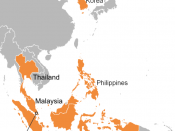The Early Warning System was originally developed by Kaminsky, Lizondo and Reinhart (KLR) in 1998. Their system was based on a signal approach. In this approach the system monitors unusual behaviors of indicators preceding a crisis. However, a senior economist in the division of International Finance identified weaknesses in the original Early Warning System. Hali J. Edison saw the need to evaluate and improve upon the econometric model that was used to anticipate financial crises specifically in markets of emerging countries. In the system Edison developed, it showed that months before the Asian financial crisis, the Asian countries already exhibited signs of vulnerability. This result then suggests that an early warning system may be used as a tool for identifying variables that may lead to a crisis.
What is an early warning system? An early warning system consists of a mechanism for predicting crisis. To generate predictions Edison uses the "signal extraction" approach.
This system involves monitoring the evolution of a number of economic indicators that tend to behave differently in a systematic way prior to a crisis and determining whether these indicators have reached levels previously associated with heightened probabilities of a future crisis. (Edison, 2000)
"The Early Warning Systems model identifies which variables tend to point out that a country might be exposed to a financial crisis event. In particular, it develops a benchmark model. This model is evaluated and based on the in-sample performance of the indicators and also the out-of-sample probabilities of a crisis. The model is shown to be accommodating in identifying vulnerabilities. This assessment of vulnerabilities can be applied to an individual country over time." (Edison, 2000)
The scope of his model include the country coverage, the choice of indicator variables and the time period. Edison decided to use a multi-country analysis for...


